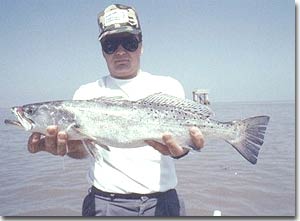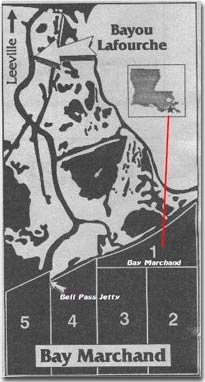Trophy Speckled Trout of Bay Marchand
Trophy Speckled Trout of Bay Marchand
By Jerry LaBella
"We don't need live bait where we're goin', we've caught 'em too many times before without it!", my companion emphasized again, as we headed down Belle Pass to the Gulf on our way to the "bait grounds."
 I explained, "If we want to be consistent in catching the larger trout, live bait will fare best!" However, neither one of us was convinced by the other.
I explained, "If we want to be consistent in catching the larger trout, live bait will fare best!" However, neither one of us was convinced by the other.
The 15 minute ride brought us to the eastern corner of East Timbalier Island. We then proceeded to wade to shore and from there to the back canal that runs parallel to the Gulf.
This area is abundant with minnows of various type. However, I had in mind the Arnold Schwarzenegger of them all, the tiger minnow. This minnow can be identified by its small pointed mouth and the perpendicular stripes on its sides. These are the ones that can "take a lickin' and keep on tickin' ". Of course, I wouldn't throw back any finger mullet, baby croakers, porgies or cocahos if they happened to get snagged in the net. These also are proper ammo for the Bay Marchand rigs, our predetermined destination.
Audible murmurs from Leroy didn't hinder me from accurately throwing the cast net, which is needed to catch these striped demons. There's no denying it is hard work having to wade through water and throw the "leads". But, after all, all Leroy had to do was pick up the bait and put them in the bucket.
Nonetheless, water temperature, tide, weather and salinity were cooperating and this we both knew. So, neither of us wasted any time, knowing only a few hours remained until sunset.
The Bay Marchand area is not what you would call a large bay along the Gulf, for it doesn't even resemble one in the true sense. Actually it is a designated block area that’s indistinguishable from the rest of the Gulf’s well defined shoreline.
Some have mistakenly considered it part of the South Timbalier demarcation to the west and south. From the shoreline near East Timbalier's western point and then running east about 12 miles the northern boundary is formed.
 These boundaries actually form sort of a blunt-tip pie wedge, setting broadside to the Gulf's shore, and within it are numerous rig structures ranging in water depth up to 45 feet.
These boundaries actually form sort of a blunt-tip pie wedge, setting broadside to the Gulf's shore, and within it are numerous rig structures ranging in water depth up to 45 feet.
It is heavily fished during the late spring through summer, but is virtually void of fishing activity in late winter and early spring (March-April).
Why? That's a good question! For it is at this seasonal transition that two factors begin to come into play: correct sea temperature (70-74), which is generally cool enough water to keep out the "bluesided piranhas"– bluefish to those who don't know–and correct salinity.
Though some 45 miles to the east of this zone lies the powerful freshwater machine, the Mississippi River, it is ineffective in infiltrating and diluting the high salinity factor common to this area.
Springtime produces the biggest trout of the year, for the most part, and that is reflected in the state record book.
The warmer waters of May bring with it the toothy critters as well, such as Spanish mackerel and bluefish, which you will have to contend with from time to time. They, too, will readily hit live baits fished from the bottom to the surface. And, they especially love those expensive and hard to find artificials that cost $4.95 and up.
As Leroy and I left the bait grounds we simultaneously focused attention on our favorite rig, the Juliet, located approximately one mile from shore and in 20 ft. of water.
With anticipation at a high, the boat didn't seem to move fast enough toward it, and the sound of the aerator in the bait box didn't help my anxiousness either.
The Juliet rig gets its name from the letter "J" in its block number (B.M.3-J),
which is only one of the more productive fishing platforms of this area. (Bay Marchand encompasses Blocks 1 through 6, inside its relatively small perimeter, however, we'll only be dealing with block 3 here.)
Fine reminiscing about the Juliet was under discussion as the gap between the rig and boat began to close. Leroy reminded me about the time a 6 lb. speck was boated using a plastic, neon glow, curly-tailed worm, jigged on bottom with a drop leader and 2 oz. weight. He remembered mistaking it for a cobia, when it rose to the surface, just before he netted it for me.
Approaching the down current side of the rig, Leroy already had the rig-hook in hand. In the gunnel pole-holder was a dangling cocaho minnow lure, being tossed about from the forward movement of the boat. Despite the live bait, he was obviously going to make his point.
The only waves produced as we latched up were those of the boat's wake, for not even a puff of wind was present. That being the case, we tied within a foot from the rig leg in order to fish as close to the structure as possible.
This of course has its advantages, but there are disadvantages as well. Many hang-ups exist around these rigs, therefore, no casting and bottom retrieving should be done when using a drop leader and live bait. Rather, allow the line to fall straight down and as close as possible to the rig leg being fished. You will find even with large trout you have the leverage, being directly on top. If the line drifts, increase weight in 1 oz. increments until it is stationary. Usually, no more than 2 oz. weight is needed.
Several casts were launched from Leroy's rod while I assembled terminal tackle consisting of only a single drop leader of 20 lb. clear mono, a 2 oz. weight on the lower drop, and a #4/0 blue sproat hook on the upper drop.
A half dozen casts went by with the usual "oohs" from Leroy, due to missed strikes or snags which caused me to hustle even more to put on one of those frisky critters–hooking it through the top lip.
No sooner did the weight hit bottom when a hard downward thrust was encountered and the rod tip pointed to the water as if to say, "They're right here!"
With an exaggerated groan I reeled with frantic motion, knowing he was watching and mimicking the words, "You don't need this bait. . . you can catch'em without it!"
Hustling back to the bait box I repeated the situation landing trout in the 2 1/4 - 4 lb. class with consistency, leaving them on the floor to be exhibited.
It didn't take Leroy long to join the ranks as a participant rather than an observer. I was not totally aware of his humility until he inquired about what type of setup I was using, right down to the precise length of leader, line, hook and weight.
Overcome with pity, I paused briefly on the way back to the bait box–dangling the terminal rig setup near his face–hoping he had enough time to observe for himself so as not to delay me and break my stride.
Now, these trout were not typical school trout, and by the trip's end we had boated several over 4 lbs. and one 6 lbs. plus, reaching our limit with ease.
However, for the sake of argument, there is no doubting the fact that good catches of trout are taken on various lures. But the facts show more consistent catches of larger trout are made with live bait, hands down. And the bigger the live bait, the bigger the trout, generally speaking.
As mentioned earlier, there are a number of other rigs in Bay Marchand that are as equally productive as the Juliet. It just so happened that we didn't need to try any other rig that evening.
Ebbing tides seem to produce best for this area, putting bag limits within easy reach for most. But productive trips have been made on incoming tides as well.
The wind is one more factor that needs to be considered during this spring transitional stage, for March brings with it the windiest time of the year. But, you will find some calm days and nights during this time if you monitor the weather closely and stay prepared to leave at moments notice. It’s advantageous to coordinate the tides and weather if you want a fruitful trip. Good trips can be had starting as early as April, provided a mild winter preceded.
The Delta structure (B.M.3-D), located southeast of the Juliet, and the C & I rig (B.M.3-C-I), located southeast of the Delta structure, are two others that are good trout producers.
The C & I rig is easily identified by the burning flare on its south side and a centrally located bridge-walk, which links this two piece structure together. The docking platform under the bridgewalk is a good producer on an ebbing tide.
The Delta structure, the centrally located rig of the two, is identified by the blue building inside the steel structured platform. The northwestern leg of this rig is a good producer on an incoming tide.
If you have never fished this area, these rigs will serve as an introduction amidst numerous other rigs which may produce as well or better.
The Bay Marchand zone ranks at the top of the list for Louisiana trophy trout.
Also, since this fishing experience, Leroy’s now the first to suggest getting live bait before we head out to fish the Bay Marchand rigs.
|
